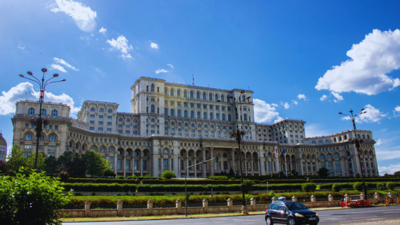ARTICLE AD BOX

There are endless structures that have broken architectural records across the world, in terms of tallest skyscraper or largest stadium, or more. These structures somehow reveal the creative genius of those eccentric builders, who dared to dream on a scale so massive that their creations continue to astonish the world even today.
Likewise, there stands one structure in the heart of Bucharest that holds a different kind of record—the world’s heaviest building. The Palace of the Parliament is not just an administrative hub; it’s a staggering monument of ambition, excess, and engineering might. With a weight of more than 4 million tonnes, this structure is as much a political legacy as it is a marvel of modern construction.
A dictator’s dream project
The origins of the Palace lie in the ambitions of Nicolae Ceaușescu, Romania’s Communist leader.
Inspired by his visit to North Korea in the 1970s, Ceaușescu embarked on a grand project of urban “systematisation,” demolishing much of old Bucharest to make way for wide boulevards and monumental buildings. At its center was the House of the Republic, later known as the People’s House and today as the Palace of the Parliament.
Construction began in 1984, and the inauguration was attended by Ceaușescu. Read more: Goa goals: 7 travel tips for a fun, safe, and unforgettable girls' trip
Heavy beyond imagination
What makes the Palace stand out is its sheer massive weight.
Built from 700,000 tonnes of steel and bronze, one million cubic meters of marble, 900,000 cubic meters of wood, and 3,500 tonnes of crystal glass, it adds up to an astounding 4.1 million tonnes. The building measures 84 meters tall, extends 92 meters underground, and has a floor area of 365,000 square meters. Its sheer heaviness is so extreme that the palace sinks six millimeters every year into the soft ground beneath Bucharest.

An architect’s monumental task
The chief architect was Anca Petrescu, only 28 years old when she won the design competition. She led a team of 700 architects and tens of thousands of workers, including soldiers and forced laborers. Construction lasted 13 years (1984–1997), and at its peak, up to 100,000 people worked on the site in shifts. Stories persist that hundreds, perhaps thousands, of workers may have died during construction, though official figures list only 27.
Petrescu’s vision blended neoclassical design with socialist realism, creating a palace that some admire for its grandeur and others criticize as a symbol of authoritarian excess. Read more: From Yellowstone to Serengeti: The 7 legends of the national park world
Palatial interiors fit for a regime
Inside, the Palace is as extravagant as its materials suggest. It contains over 1,100 rooms, though many remain unused, including ornate halls, grand staircases, and vast galleries. The interior features 480 chandeliers, 1,409 ceiling lights, massive handwoven carpets, and velvet curtains embroidered with silver and gold thread.
The craftsmanship relied heavily on Romanian resources, from oak and walnut wood to native marble, making it a showcase of the country’s natural wealth.

A building too big to use
Today, the Palace houses Romania’s Senate and Chamber of Deputies, the Constitutional Court, and several museums, including the National Museum of Contemporary Art. Yet despite its scale, only about 30% of the building is in active use, leaving much of it empty.
It is also the most expensive administrative building in the world, valued at €4 billion as of 2020. Just keeping the lights on and heating the enormous halls costs over $6 million per year, a burden that continues to spark debate among Romanians.
Legacy of the People’s House
Since its completion, the Palace of the Parliament has become one of Romania’s most visited landmarks. Tourists are awed by its size, yet it remains controversial—a reminder of the costs of dictatorship, both financial and human. Some call it a “Pharaonic” project, comparing it to the Great Pyramid of Giza, which it even surpasses in volume.



.png)
.png)
.png)
















 7 hours ago
4
7 hours ago
4








 English (US) ·
English (US) ·